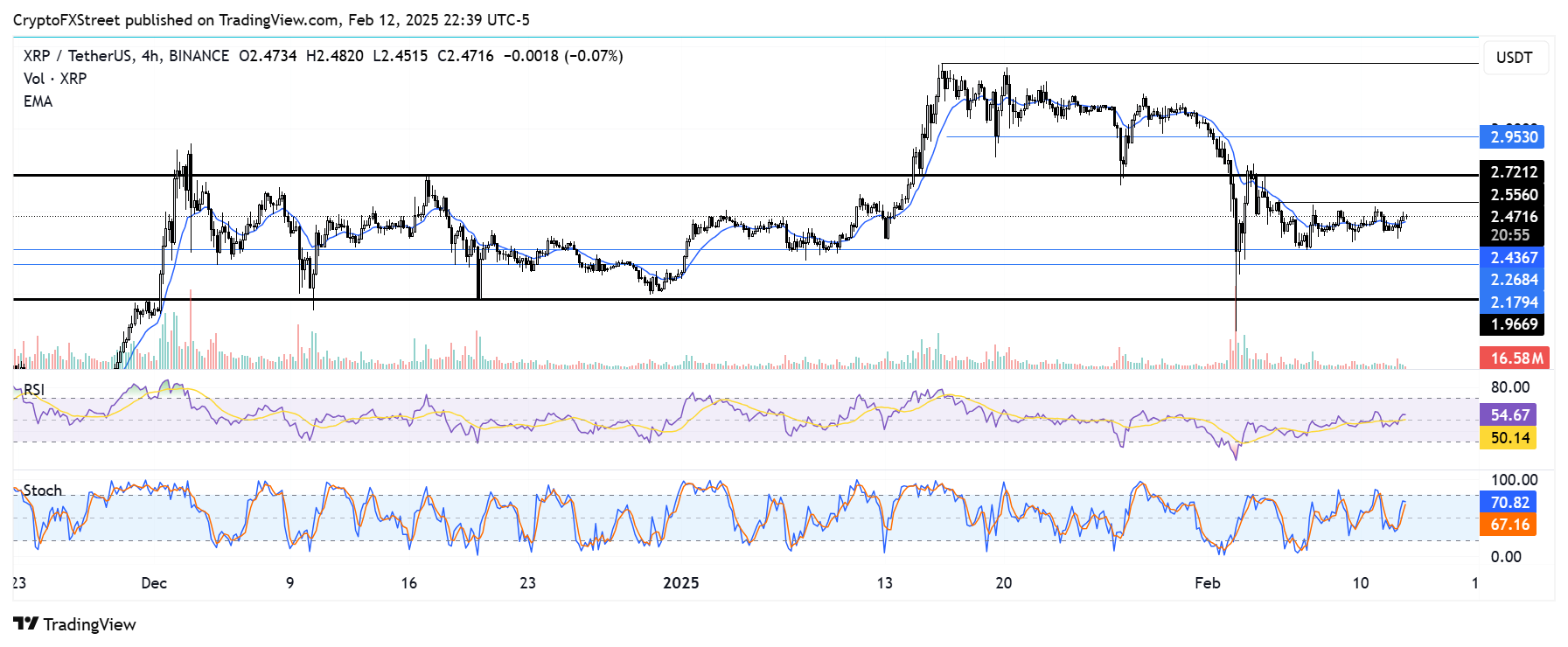Ripple’s XRP records slight gains as investors begin accumulation

- XRP investors have been accumulating following an uptrend in the Mean Coin Age metric.
- However, the XRP derivatives market is yet to recover from a 30% open interest decline in the past week.
- XRP eyes $2.55 but risks liquidating long positions worth over $80 million if it declines to $2.26.
Ripple’s XRP is up 2% in the early Asian session on Thursday following rising accumulation among investors and a potential bottom signal in the MVRV Ratio.
XRP on-chain data indicate accumulation as derivatives trades stall
After the February 3 crypto market crash, XRP investors have largely switched towards accumulation in the past five days as buy-the-dip sentiment is becoming prevalent.
On-chain data shows that XRP has seen very minimal selling activity and more accumulation as indicated by an uptrend in Mean Coin Age metric. This metric shows the average number of days all XRP tokens remained in their current addresses. An uptrend signifies network-wide accumulation and vice versa for a downtrend.
XRP Mean Coin Age. Source: Santiment
Also, the 30-day Market Value to Realized Value (MVRV) ratio is indicating a potential bottom after hitting -17% in the past week. The last time this metric saw such low levels, XRP rallied over 60%. If history repeats itself, XRP could see a rally in the coming days.
%20%5B04.26.43,%2013%20Feb,%202025%5D-638750157201606758.png)
XRP 30-day MVRV Ratio. Source: Santiment
Despite signs of accumulation in the spot market, XRP’s derivatives market shows traders are largely exercising caution. XRP’s open interest has declined over 30% from 2.05 billion XRP to 1.42 billion XRP.
Open interest is the total amount of unsettled contracts in a derivatives market. XRP’s OI needs to grow to help fuel a rally.

XRP Open Interest. Source: Coinglass
Meanwhile, the SEC acknowledged Grayscale’s XRP ETF filing on Tuesday, following a 65% chance of approval placed on them by Bloomberg analysts Eric Balchunas and James Seyffart.
XRP eyes $2.55 but could spark an $80 million long squeeze if it declines toward $2.26
XRP saw $5.91 million in futures liquidations in the past 24 hours, per Coinglass data. The total amount of liquidated long and short positions accounted for $2.80 million and $3.11 million, respectively.
Since the February 2-3 market crash sparked by anticipation of a global trade war, XRP has been trading within a key rectangular channel marked by the $2.26 support level and the $2.55 resistance level. The current price trend signifies uncertainty among traders as the crash wiped out several long traders.

XRP/USDT 4-hour chart
However, if XRP moves above the $2.55 level and successfully overcomes the resistance near $2.72, it could incentivize a high volume of bullish bets to return to the market.
On the downside, if XRP breaches the $2.26 support, it could spark a more than $80 million long squeeze, per Coinglass data. In such a scenario, XRP could find support at $1.96.
The Relative Strength Index (RSI) and Stochastic Oscillator are above their neutral levels, indicating short-term bullish momentum.
A daily candlestick close below $1.96 will invalidate the thesis.
SEC vs Ripple lawsuit FAQs
It depends on the transaction, according to a court ruling released on July 14, 2023: For institutional investors or over-the-counter sales, XRP is a security. For retail investors who bought the token via programmatic sales on exchanges, on-demand liquidity services and other platforms, XRP is not a security.
The United States Securities & Exchange Commission (SEC) accused Ripple and its executives of raising more than $1.3 billion through an unregistered asset offering of the XRP token. While the judge ruled that programmatic sales aren’t considered securities, sales of XRP tokens to institutional investors are indeed investment contracts. In this last case, Ripple did breach the US securities law and had to pay a $125 million civil fine.
The ruling offers a partial win for both Ripple and the SEC, depending on what one looks at. Ripple gets a big win over the fact that programmatic sales aren’t considered securities, and this could bode well for the broader crypto sector as most of the assets eyed by the SEC’s crackdown are handled by decentralized entities that sold their tokens mostly to retail investors via exchange platforms, experts say. Still, the ruling doesn’t help much to answer the key question of what makes a digital asset a security, so it isn’t clear yet if this lawsuit will set precedent for other open cases that affect dozens of digital assets. Topics such as which is the right degree of decentralization to avoid the “security” label or where to draw the line between institutional and programmatic sales persist.
The SEC has stepped up its enforcement actions toward the blockchain and digital assets industry, filing charges against platforms such as Coinbase or Binance for allegedly violating the US Securities law. The SEC claims that the majority of crypto assets are securities and thus subject to strict regulation. While defendants can use parts of Ripple’s ruling in their favor, the SEC can also find reasons in it to keep its current strategy of regulation by enforcement.




